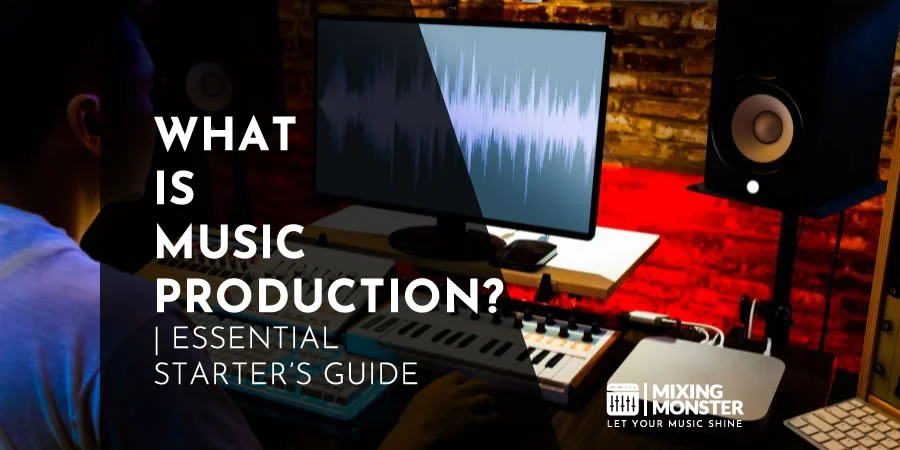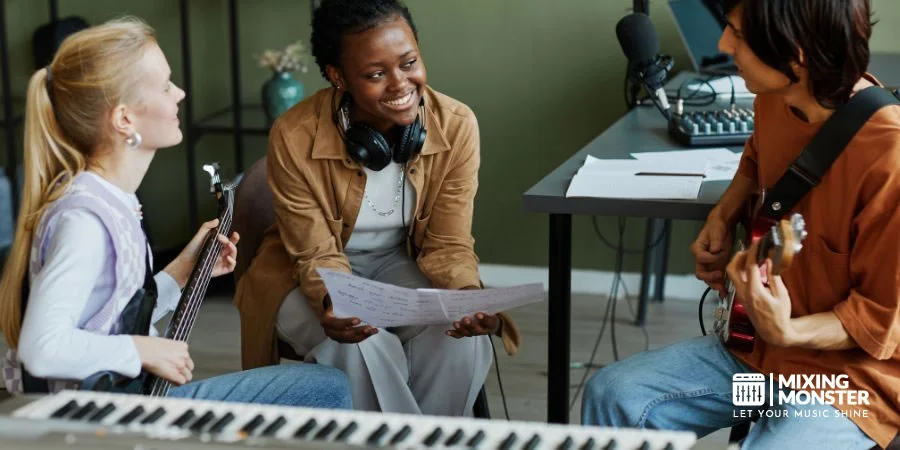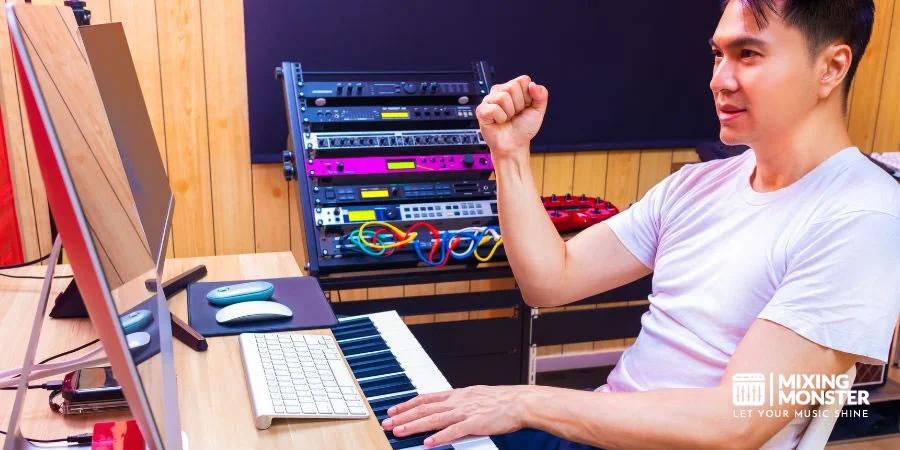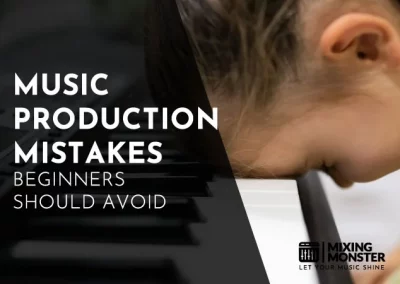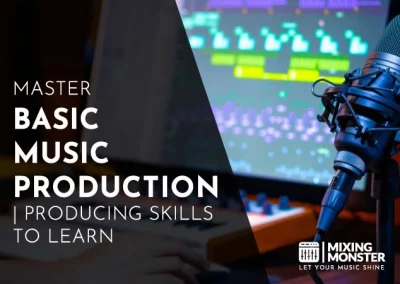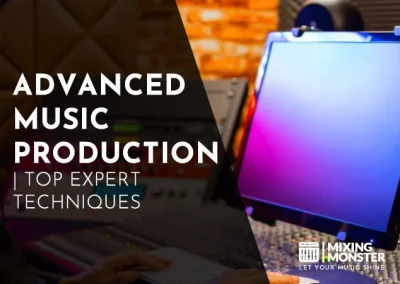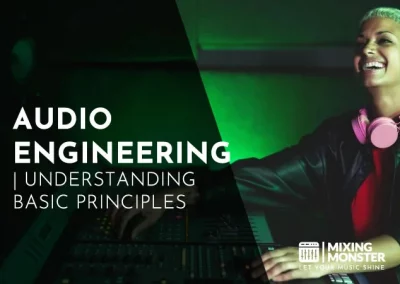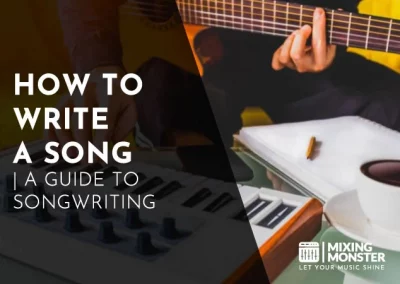Home > Blog > Music > Music Production
Disclosure: Some of the links below are affiliate links, meaning that at no additional cost to you, we will receive a commission if you click through and make a purchase. Read our full affiliate disclosure here.
Venturing into music production can feel like exploring a new universe of sound. It’s an exciting and complex field where technology meets creativity, and you are the helmsman guiding each element to craft a coherent sonic story. The role of a music producer is pivotal; they sculpt the raw musical ideas into a polished final product, ready for listeners to experience.
Music production encompasses everything from songwriting and composition to recording, mixing, mastering, and everything. A producer is responsible for a music project’s overall vision and direction. They work closely with artists and musicians to refine their sound, using hardware and software tools to achieve the desired result. Digital Audio Workstations (DAWs) have become indispensable in modern music production, providing tools for editing, arranging, and manipulating audio.
As you delve into this article, you’ll uncover the essential building blocks of music production. Each section will provide you with a deeper understanding of the intricacies involved—whether it’s the fundamentals of sound, the role of DAWs, recording techniques, or the vast array of equipment and tools at your disposal. With the insights and information presented, you’ll be well-equipped to start your journey into the art and science of making music.
KEY TAKEAWAYS:
- Music production is a comprehensive process involving creative and technical skills.
- The producer plays a central role in shaping the sound and direction of music.
- Understanding DAWs and other tools is crucial for producing quality audio.
Table Of Contents
1. What Is Music Production?
2. Fundamentals Of Sound And Audio In Music Production
3. Digital Audio Workstations For Music Production
4. Music Production Recording Techniques
5. Audio Editing Basics
6. Music Production Mixing Essentials
7. Music Production Mastering Process
8. Music Production Equipment And Tools
9. Advancements In Music Production
10. Exploring Music Genres And Creative Styles
11. Starting Your Music Production Journey
12. FAQ

1. What Is Music Production?
When you embark on music production, you enter a multifaceted field integral to creating recorded music. You’ll learn the role of a music producer and the collaborative nature of music production with artists within the music industry.
Music Production Overview
Music production is the entire process you undertake to create a finished piece of music. It involves composing, arranging, recording, mixing, and mastering tracks. As you advance in your production skills, you understand that each step is vital in shaping the final product.
Overview of Music Production Process:
| Step | Description |
|---|---|
| Composing | Crafting the melody, harmony, and rhythm |
| Arranging | Determining the musical elements and how they will be used |
| Recording | Capturing the musical performances |
| Mixing | Balancing and combining individual tracks |
| Mastering | Finalizing the audio for distribution |
What Does A Music Producer Do?
A music producer guides the entire music production process, often likened to a film director. Your role might include:
- Defining the vision for a project.
- Shaping the sound, coaching artists.
- Ensuring that the project stays on budget and schedule.
You could be an alchemist of sound, blending different elements to create an audible work that reflects your vision and the artist’s unique style.
Music Production Collaboration With Artists
The symbiosis between you as a producer and the artists is paramount. In the music industry, this collaboration can make or break a record. You bring out the best in the artist, often pushing them to explore new territories.
Conversely, the artist’s visions and talents can significantly inform and influence your production choices. This working relationship holds the potential to yield musical innovation and chart-topping hits.
2. Fundamentals Of Sound And Audio In Music Production
Sound dynamics and acoustics are pivotal elements in music production. Understanding these fundamentals will shape how you manipulate audio to achieve professional quality in your tracks.
Exploring Sound Dynamics
Sound dynamics refer to the variation in loudness between notes in a piece of music. The primary dynamics you will encounter include volume and balance, both crucial for creating depth and movement in your tracks.
Use an equalizer (EQ) to control these elements effectively. An EQ allows you to adjust the audio frequencies, enhancing or diminishing specific aspects of the sound.
For instance, if a vocal track is masking the subtleties of a guitar riff, you would use EQ to reduce the overlapping frequencies. Audio interfaces and microphones also play a significant role, contributing to the dynamic quality of the recorded sound.
High-quality microphones can capture the pitch and dynamics of performance accurately, while an audio interface is integral for transferring this data into your Digital Audio Workstation (DAW) with clarity.
Introduction To Acoustics
Acoustics is the science of how sound is transmitted through an environment. In a studio setting, the room’s acoustics can significantly affect the outcome of your recordings. You can manipulate your studio’s acoustics using diffusers and absorbers to reduce unwanted reflections and balance the sound.
When positioning microphones, consider the microphone’s pickup pattern and the source’s position within the room. How sound waves bounce off walls and surfaces influences what the microphone captures.
Moreover, understanding how different materials and shapes impact sound can lead to informed decisions about studio design and setup, ultimately affecting your recorded audio’s quality.
3. Digital Audio Workstations For Music Production
In music production, Digital Audio Workstations (DAWs) are indispensable tools that allow you to record, edit, and produce music digitally. Selecting a DAW that resonates with your workflow and mastering its features can significantly enhance your music production process.
Choosing The Right DAW For Music Production
When determining which DAW is best for your music production needs, consider the genre you’re working with and your experience level. Beginner-friendly DAWs like GarageBand offer a straightforward platform for beginners.
On the professional end, Pro Tools is widely regarded as the industry standard for audio editing in music and film due to its comprehensive editing capabilities.
Popular choices among electronic music producers include Ableton Live, with its robust live performance features, and FL Studio, favored for its intuitive sequencing and pattern-based workflow.
With its extensive library of virtual instruments, Logic Pro provides a versatile, particularly powerful environment for composition and orchestration.
Essential DAW Features For Music Producers
Your DAW should empower you with features to streamline music production. Key features include:
- Multitrack Recording:
You can record multiple inputs, like instruments and vocals, onto separate tracks. - Editing Tools:
Look for powerful editing capabilities that precisely manipulate recorded audio, including cutting, moving, and stretching clips. - MIDI Support:
MIDI is essential for electronic music production, allowing sequencing and software instrument control. - Mixing And Effects:
Integrated mixing consoles and built-in effects, such as reverb, compression, and EQ, are crucial. - Compatibility:
Ensure your DAW supports the plugins and virtual instruments you plan to use.
It’s essential to work with a DAW that feels intuitive to you. Many DAWs, including the ones mentioned, offer trial versions, so take the opportunity to test them out and find the best fit for your music production endeavors.
4. Music Production Recording Techniques
In this section, you’ll learn about specific recording techniques for capturing high-quality music production sound. The right approach to recording can significantly impact the final product.
Microphone Selection
Choosing the correct microphone is pivotal to the quality of your recordings. Condenser microphones are ideal for capturing detailed and nuanced sounds, and due to their sensitivity and wide frequency response, they are widely favored for studio vocals and delicate instrumental sounds.
On the other hand, dynamic microphones are more robust and better suited for loud sound sources such as drums and guitar amplifiers, thanks to their ability to handle high sound pressure levels without distortion.
Instrument Recording
When you’re recording instruments, it’s about more than just playing the notes correctly. Attention to detail in mic placement can dramatically alter the tone and texture of the recording.
For example, placing a mic close to a guitar amp captures a more direct and intense sound, while moving it away will include more of the room’s ambiance. Additionally, consider recording multiple takes and layering them to create a fuller sound, which can add depth and richness to the final mix.
Vocal Performance Capture
The room’s acoustics and the singer’s technique play significant roles in vocal recording. A well-insulated room can prevent unwanted echoes and noise from tarnishing the clarity of the vocals.
Ensure the singer is comfortable and the microphone is positioned correctly, often at mouth level and a few inches away, to avoid plosives. Using a pop filter with your microphone can also help reduce unwanted acoustic artifacts, allowing for a clean and clear vocal performance.

5. Audio Editing Basics
Editing is a pillar of music production, ensuring every element sounds its best. You’ll work with a Digital Audio Workstation (DAW), a multipurpose tool for trimming clips to correct timing issues, adjusting pitch to ensure vocal harmony, and utilizing MIDI data to alter synthetic instrument parts. Effective editing often involves:
- Cutting:
Removing unwanted noise or silences. - Copying:
Duplicating sections to create repetition. - Pasting:
Placing copied sections in the desired locations. - Fading:
Smoothing the entry or exit of audio clips.
DAWs, such as Ableton Live or FL Studio, offer an extensive toolbox for fine-tuning melodies, tempo, and lyrics.
Arranging Musical Elements
Arrangement refers to the strategic placement and progression of musical elements throughout a track. Consider arrangement as the skeleton that holds the music together, shaping how a listener experiences the journey from start to finish. Key aspects to focus on include:
- Structure:
Deciding the order of verses, choruses, bridges, etc. - Instrumentation:
Determining which instruments play and when. - Dynamics:
Controlling the loudness and energy throughout the piece.
A well-thought-out arrangement keeps your melodies engaging and ensures the music flows naturally. Keep the listener intrigued by varying the arrangement, introducing new elements, or stripping back others to create contrast and maintain interest.
6. Music Production Mixing Essentials
In music production, mixing is a critical phase where you combine and manipulate the individual tracks of a song to create a single polished piece. It balances art and science, requiring attention to detail, a good ear, and familiarity with your digital audio workstation (DAW).
Understanding EQ And Dynamics
Equalization (EQ) is essential to shape the tonal balance of your mix by boosting or cutting frequencies to minimize clashes and enhance clarity. When you adjust EQ settings, you direct which instruments stand out at various points in the song.
Dynamics, such as compression, are vital for controlling your mix’s volume levels and energy. Compression reduces the dynamic range by making softer sounds louder and loud sounds softer, contributing to a more consistent level of audio.
- EQ Tips:
- Cut rather than boost to avoid adding unwanted noise.
- Use a high-pass filter to eliminate low-end rumble from tracks that don’t need it.
- Compression Guidelines:
- Set a threshold to determine when compression begins.
- Use a ratio to control the amount of compression applied once the threshold is breached.
Spatial Effects And Panning
Spatial Effects
Panning allows you to position elements of your mix in the stereo field, from left to right, helping create balance and prevent overcrowding in any area.
- Reverb Use:
- Tailor reverb types to match the space you envision for your track.
- Apply subtly to avoid washing out crucial elements.
- Panning Techniques:
- Pan rhythm instruments like guitars and keyboards are placed on opposite sides to create a wide stereo image.
- Keep low-frequency elements like bass and kick drum centered to maintain a strong, balanced foundation.
Automation plays a significant role in mixing by allowing you to make precise adjustments to effects, panning, and volume over time, adding movement and interest to the track.
Using your DAW, blend these elements thoughtfully, aiming for a clean, balanced, and dynamic mix that translates well across various listening environments.
7. Music Production Mastering Process
Mastering is the final stage in the music production process that polishes your mix and prepares it for distribution. This stage enhances the overall sound quality, ensuring consistency and playback optimization across all media formats and devices.
Finalizing The Mix
In mastering, the goal is to achieve a balanced and cohesive sound. You’ll apply EQ to fine-tune frequencies, ensuring no particular frequency range dominates the mix.
Precise compression controls the dynamics, while limiters prevent any part of the audio from clipping and causing distortion. Your focus on achieving consistent volume levels across the track adds to the final polish, ensuring a professional sound.
- EQ Use:
To remove unwanted frequencies and to enhance desired ones. - Compression:
Applied subtly to tighten the mix without over-compressing. - Limiters:
To ensure the maximum loudness without distortion.
Preparing Music For Distribution
Once the mix is finalized, mastering ensures your music sounds excellent on any playback system, from a car stereo to club loudspeakers. The process involves adjusting the overall volume to industry standards and creating a balance that translates well across different listening environments.
- Volume Standardization:
Achieving loudness that meets industry standards. - Playback Consistency:
Checking that your track translates well across various systems.
Remember, mastering can significantly enhance your track record but requires critical ear and technical expertise. It’s often recommended that you employ a professional mastering engineer to ensure the best results.
8. Music Production Equipment And Tools
The right selection of equipment and tools is pivotal to the quality and ease of your music production process. Here, you’ll discover the essential gear for a functional setup and the differences between traditional hardware and software-based production.
Music Production Gear
Your home studio setup should consist of several critical pieces of gear:
- Audio Interface:
This is your gateway between the analog and digital realms, converting microphone and instrument signals into a format your computer can work with. - Microphone:
A good microphone is essential for capturing vocals and acoustic instruments. - MIDI Controller:
MIDI controllers, like keyboards or drum pads, allow you to input notes and control virtual instruments in your digital audio workstation (DAW). - Headphones:
A reliable pair of headphones is necessary for monitoring your audio during recording and mixing. - Synthesizers And Drum Machines:
These are vital for creating electronic sounds and beats, should your genre require them. - Samplers:
A sampler can record and playback samples, adding unique audio to your tracks.
Additionally, you’ll need:
- DAW:
The software where all recording, editing, and mixing occurs. - Plugins:
These software counterparts to hardware processors can include effects, virtual instruments, and utilities to help shape your sound. - Monitors:
Studio monitors are crucial for accurate sound reproduction during mixing.
Investing in quality gear from the start can go a long way in ensuring your productions sound professional.
In-The-Box Vs. Out-Of-The-Box
In-the-box production creates music entirely within a computer using a DAW and plugins. This method is cost-effective and offers extensive flexibility and recallability.
- Pros:
It’s less space-consuming, and you have a virtually limitless palette of sounds and instruments. - Cons:
It can be less tactile than using physical gear, and the learning curve for software may be steep for some.
Out-of-the-box production involves using physical hardware like synthesizers, drum machines, and outboard gear.
- Pros:
Hardware offers a more hands-on experience and can sometimes provide warmth or character that many producers prize. - Cons:
It can be more expensive, require more space, and slow workflow.
9. Advancements In Music Production
Digital technology and mobile platforms have revolutionized the landscape of music production. Let’s explore these developments and how they empower you to create music in once unimaginable ways.
The Music Production Shift To Digital
Moving from analog to digital has been a game-changer in music production. Your Digital Audio Workstation (DAW) is now the core of music-making, replacing bulky hardware with a streamlined, software-based environment.
High-powered computers and laptops have become your new instruments, hosting a wide array of digital tools. With virtual instruments and an extensive selection of plugins, you can replicate the sounds of real instruments, synthesizers, and effects processors within your DAW.
The beauty lies in their limitless potential without the physical limitations of traditional hardware.
- Virtual Instruments:
Use sounds from an immense library that you can manipulate in ways physical instruments cannot. - Plugins:
Incorporate new effects and processing tools by downloading them without purchasing additional gear.
Mobile Music Production Platforms
The emergence of mobile platforms has made it easier to produce music. You can transform your tablet or smartphone into a portable production studio with robust apps.
These apps allow you to sketch ideas, mix, and even master tracks on the go. This means that inspiration is always preserved due to the absence of a formal studio setting.
- Tablet and Smartphone Apps Offer a surprising depth of control and features, making them almost as powerful as desktop-based DAWs for specific tasks.
- Accessibility:
Changes in music production now allow you to initiate projects anytime, anywhere, breaking free from the confines of the studio.
10. Exploring Music Genres And Creative Styles
Regarding music production, the genre greatly influences your techniques and creative decisions. Understanding these will allow you to mold your distinctive style within the vibrant tapestry of music.
Influence Of Genre On Music Production
Each genre has its signature elements that dictate how a song is produced. For instance, pop production is often crisp and radio-friendly, emphasizing memorable melodies and hooks.
House music, a branch of electronic dance music (EDM), is characterized by repetitive 4/4 beats and often relies on building layers of texture and rhythm to engage listeners. Moving to hip-hop, the production is rhythmically complex, with beats that sample various sources and lyrics that deliver a potent message.
In rock music, production varies from raw and gritty to polished, but it usually features live instruments like guitars, bass, drums, and vocals at the forefront. Your personal preference plays a vital role in shaping the nuances you bring to the production process within these genre frameworks.
Personalizing Your Music Production Style
Your unique style emerges from the fusion of your preferences with genre conventions. It’s crucial to experiment and trust your instincts. Feel free to add italicized synths to a rock track if it enhances the song or blends hip-hop rhythms in a pop production for an unexpected twist.
Meshing different genre elements allows you to develop a production style that is uniquely yours. Drawing from diverse musical forms while staying true to your artistic vision will help you craft a sonic identity that resonates with listeners.
11. Starting Your Music Production Journey
Embarking on your music production journey equips you with the creativity to craft songs and the potential to impact the music industry. Whether your aspirations involve songwriting or sound engineering, starting with foundational knowledge and tools is crucial.
Beginner Tips For Music Production
First and foremost, understand that the essentials of music production for beginners span various aspects. As you start producing music, you must familiarize yourself with the basic song structures and common production terms.
Begin with learning how to create simple beats and melodies. Here are some specific pointers:
- Listen actively to various music to understand different genres and production styles.
- Learn the basics of songwriting, including structure and music theory, to improve your compositions.
Building Your Home Studio For Music Production
Creating a functional home studio can be a manageable investment. You’ll need some essential gear to get started:
- Studio Monitors:
Invest in quality studio monitors that provide accurate sound representation. - Controllers:
A MIDI controller is invaluable for inputting musical notes and controlling your Digital Audio Workstation (DAW).
Remember, the space itself matters. A quiet room with minimal echo is ideal for a home studio – you can enhance this with some basic soundproofing.
Key Takeaways For Your Music Production Journey
Adopting a systematic approach to music production is beneficial for any beginner. Be patient, consistent, and ready to learn from every project:
- Set realistic goals as you practice; your skills will grow with time.
- Stay updated with the latest trends and technologies in the music industry to keep your work relevant.
Happy music production!
12. FAQ
1) What skills are essential for becoming a successful music producer?
To thrive as a music producer, you need a blend of technical proficiency in music software and equipment and soft skills like communication and collaboration. Continuous learning and networking within the industry are also vital.
2) How does one begin a career in music production?
Starting a career in music production often involves learning the basics through education and hands-on practice. Build a foundation with a solid understanding of music theory and technology, followed by creating and sharing your work to gain experience and recognition.
3) What distinguishes music production equipment as essential for creating quality music?
Essential music production equipment includes a powerful computer capable of handling recording software, a reliable Digital Audio Workstation (DAW), and high-quality recording hardware, the bedrock of producing professional-grade music.
4) Can you explain the music production process from start to finish?
The music production encompasses composing, arranging, recording, mixing, and mastering. The journey starts with a song idea, develops through recording and layering tracks, and concludes with refining the final mix to create a polished track.
5) How do music producers differ from record producers in their roles and responsibilities?
Music producers primarily focus on creating the music, including composing and sound design. Conversely, record producers often oversee the overall project management, working with artists to realize their creative vision and shape the record’s sound.
6) In terms of compensation, what can a music producer expect to earn?
Music producers can expect to earn varying amounts based on their expertise, reputation, and niche within the industry. Rates can range from project-based fees for independent work to substantial salaries for established producers working with major artists and labels.

